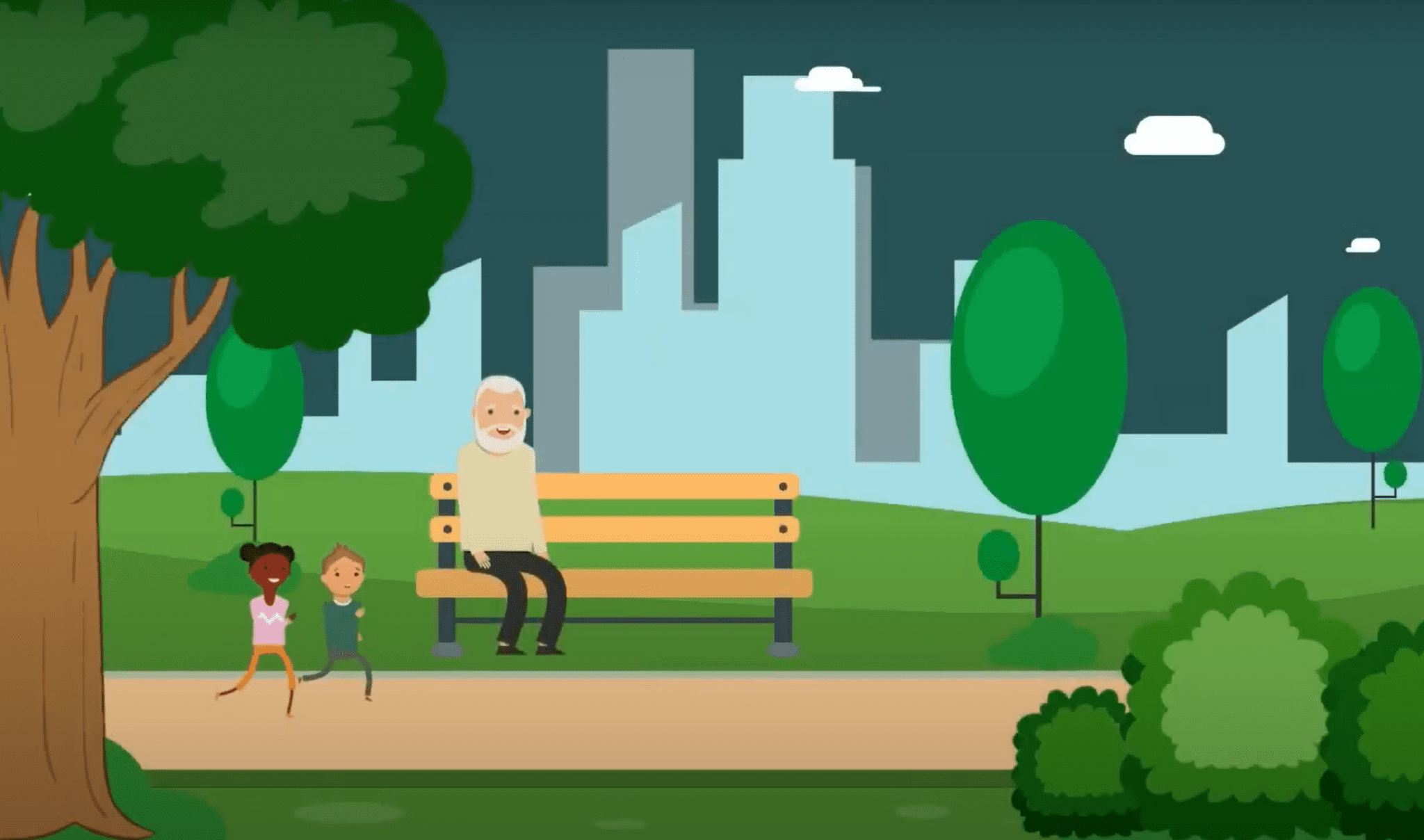
Discover how care professionals support wellbeing
Introduction: Staying safe and well
What is wellbeing?
Wellbeing is an important concept in caring careers. It’s a rich and interesting topic, with endless opportunities to develop your understanding. Child and adult care professionals are knowledgeable and passionate about wellbeing. Therefore, if this topic is of interest we would strongly encourage you to take steps towards this type of career.
To get you started, here’s a simple way of thinking about wellbeing:
Wellbeing is a state of feeling good or feeling healthy.
This is not just feeling good or healthy in a physical sense, but also about how we feel mentally, emotionally, socially and spiritually.
Video: What is health and wellbeing: Public Health Scotland

Play this video from Public Health Scotland. It explains that wellbeing is more than just the absence of health problems or illness. It’s also about important social conditions like income level, access to nutritious food and educational opportunities.
There are many more important social aspects of life which affect our wellbeing, like our relationships and our feeling of belonging at home and in our community. Sadly these are sometimes overlooked within society, leading to some people experiencing loneliness and reduced opportunities for example. Care professionals recognise the importance of promoting these social aspects of wellbeing alongside physical health and it’s for this reason that the term ‘social care’ is used.
Some public service organisations will use a specific definition of wellbeing to guide their work, shaped by the needs of those they want to support. So you may be introduced to specific definitions depending on the type of role you have, and the people you support. For example, the following definition from Children in Scotland was written for people who work with children. It contains eight indicators of wellbeing and is known by its abbreviation, SHANARRI.
Every child has a right to be safe; healthy; achieving; nurtured; active; respected; responsible; and included. This is how we define ‘wellbeing’ in the Children and Young People (Scotland) Act 2014.
You can look up ‘SHANARRI’ on the internet if you want to see examples of it being used.
We all have an equal right to wellbeing, regardless of whether we are young or old, rich or poor, or if we live with a health condition or disability. We should all enjoy good access to services and support which helps us achieve the best level of wellbeing, and for some of us the contribution of social care services will be vital.
If you want to read more about wellbeing, click on each of the rows below to reveal or hide more information. Then keep scrolling to the first topic.
1. How did care workers support others during the COVID-19 pandemic?

From the start of the pandemic, the care workforce went above and beyond to support people receiving care. In recognition, the SSSC published the Inspiring Care Stories which demonstrate the values, compassion and professionalism of care workers across Scotland.
Kirsty is a support worker who works with children with learning disabilities in an organisation called Supporting Positive Paths in Edinburgh. Here’s a quote from Kirsty’s Inspiring Care Story.
This is a scary time for all of our children we look after, especially those who can’t understand the situation, and those who have additional physical health conditions which means they can’t leave their house.
To reach these children who we can’t see in person, I started a YouTube channel for our company where I am making music videos with sign language. A lot of our children are non-verbal and communicate with signs.
Kirsty – Support Worker, Supporting Positive Paths
Kirsty’s quote provides a powerful example of the concern care workers have for the wellbeing of others. Kirsty was worried about the risk of emotional harm to children whose health conditions meant they were spending much of their time inside, isolated from people they knew. She came up with a creative, fun and educational activity which recognised the children’s unique needs. It’s likely that the opportunity to take part and stay connected to their support service increased the children’s emotional wellbeing. It’s also likely the children’s families and Kirsty’s colleagues benefited from her work.
Read the stories
Take some time to read some more of the stories which are organised in this image under six themes.
Clicking on a button will open a Sway (a type of digital presentation) in a new tab where you can read the story and play videos where available.
Once you’ve read some stories, come back to this page and try some of the activities below.
Question: Choose one or two of the stories to think about in more detail. Can you identify some of the risks of harm which led the care workers to create the new activities and supports described in the story?
Question: In your opinion, in what ways have the care workers in the story supported the wellbeing of others?
If you want to keep a record of your notes we recommend using MyLearning.
2. How can care workers support their own wellbeing?
A career in care is life-changing, for you and the people you will work with. You’ll have opportunities to make a difference in someone’s life, from providing comfort in times of distress to being there to celebrate the big things they can achieve with the right support. It’s no wonder why many current care workers call it the most rewarding job they’ve ever had.
The rewarding nature of the work is strong motivation for starting a career in care, and if it has made you consider this career that’s great news! While we want to encourage more people into these important roles we also want to make sure that, as part of your preparation, you’re informed about some of the challenges you’ll face, particularly in times of crisis like a pandemic, and the supports available to you and future colleagues to maintain a good level of wellbeing at all times.
During the pandemic, what difficulties did care workers experience and how did they overcome them?
Click on the rows below to hide or reveal more information.
Video: Supporting your wellbeing: National Wellbeing Hub

There’s a new National Wellbeing Hub for all health and social service workers in Scotland. Here’s a short video about it
About The Wellbeing Hub
The Wellbeing Hub contains numerous help resources like articles, podcasts (an audio based resource) and webinars (a class or workshop shown over the internet). Some resources are short (like this six tips for a better sleep ) and some take more time (like this podcast for working parents which is about one hour long).
While the Wellbeing Hub was created for current health and social care workers it may be helpful for you too. If there’s something worrying you at the moment we’d recommend you take a look at the resource list and see if there’s something to read, watch or listen to which may give you new ideas for taking care of your own wellbeing.
The Wellbeing Hub also can point you towards free wellbeing apps and online programmes. There’s also a page about services which include local services and a new national helpline. The most important thing is that you find something which works for you, and is in the format you prefer.
Click on the rows below to try the activity questions and reveal more information about wellbeing and further learning.
Here are some questions to consider, if you don’t wish to do them all choose one or two. If you want to keep a record of your notes we recommend using MyLearning.
Question: Take some time to look around the Wellbeing Hub and identify some pages and resources which are of interest to you. Are there types of resource which interest you more? For example, do you prefer to read documents or do you like podcasts or videos?
Question: Can you explain why it’s important for care workers, and their employers, to make time to focus on wellbeing?
Question: Can you identify skills and qualities you have which would help you promote wellbeing in the workplace? Perhaps you have experience from a previous job or unpaid caring role?
3. What’s it like to work alone in the community, or as part of a team?
Working as part of a team
During the pandemic we gathered stories of care professionals because we wanted to share their inspiring skills and qualities. This team from Aberdeenshire Health and Social Care Partnership explain how relationships, communication and leadership helped them through a difficult period.
Everyone working in care will need to be able to work as part of a team, whether that’s a large team or a very small one. As seen in the video, sometimes a team will stay in touch using technology rather than always meeting in person. Take some time to play the video to understand how team members can support each other, and why it’s important.
Video: Tough times don’t last, tough teams do: SSSC

Tough times don’t last, tough teams do
Working alone
In some services, like care at home or housing support, you may be working on your own more than usual. This is sometimes called being a ‘lone worker’. This is a common feature of many roles in care, even if you’re only working alone some of the time. If you start work in a role like this you will be shown how to keep in touch with your team and your manager.
Some people enjoy working alone some or most of the time. Skills for Care (an organisation which supports care workers and employers in England) asked care workers what they enjoyed about this kind of work, and found they liked:
- the rewarding nature of being able to provide one-to-one, personalised care and support for people
- the opportunity that lone working provides to build and sustain relationships with the people they support
- witnessing the positive effects that regular and consistent one-to-one care and support can have on the people they support, particularly around happiness and general demeanour.
Managing risks for lone workers
Working alone may bring particular types of risk. If you have an accident or encounter a problem there may not be someone nearby, so it may take longer for help to reach you. No matter what the potential risk is there should always be an identified way that it will be managed by your employer, with your cooperation, so that you can keep safe.
Your employer will have more guidance for you if you start working in this kind of role. Always speak with your manager if you have any concerns about risks which aren’t being appropriately managed.
Here are some examples of risks faced by lone workers, with suggestions for how they can be managed. Click on, or tab to, the solutions for each type of risk. It’s important to be aware of these so you can act appropriately if you need to, however you shouldn’t expect these to happen very often.
Personal safety
Risks: You may be walking, driving or getting public transport to new or unfamiliar environments and at different times of the day, like early in the morning or late in the evening.
Moving and assisting
Risks: You may need to move items in someone’s home when preparing to support them and there is a risk of injury if it’s not done correctly.
You may also support people to move around their home and the community which brings additional risks.
Acting within the limits of your role
Risks: When working alone you may encounter a difficult problem and feel that you should solve it, even if this is not part of your role and therefore not covered within your training.
Supporting someone in distress
Risks: You may need to support someone who is distressed. Distress (which for example can be caused by confusion, fear or illness) can sometimes, but not usually, lead someone to act abusively to the workers who are there to support them.
This can be an upsetting experience, particularly if working alone.
Click on the rows below to hide or reveal activity questions and access further resources.
Here are some questions to consider, if you don’t wish to do them all choose one or two. If you want to keep a record of your notes we recommend using MyLearning.
Question: Would you prefer to always working with other colleagues, for example in a care home or childcare nursery, or do you think you would be good at working alone in the community visiting people in their homes? (This will shape the types of job you might want to apply for.)
Question: Can you think of any other ways that lone workers can stay safe when out working in the community? Perhaps you have used strategies in other jobs, or in your personal life?
Question: In your opinion, what are the benefits of working as part of a team?
Question: If one of your colleagues was worried or had an upsetting experience, what could you do to help them?
End of section

You’ve now completed the first section of this resource. Scroll down to find the next section.
We encourage you to take some notes on the MyLearning app as you go along of the things you find interesting, or answers to some of the activity questions. This could help you later as you prepare to start your career.
More sections in this resource
This resource has three sections to work through, all related to staying safe and well. Each of the sections includes a number of topics.

Understand the care workforce’s contribution to public health
In this section, we’ll take a look at the many ways in which the care workforce are contributing to the health and wellbeing of others, not just individuals but the Scottish population as a whole. This is also known as Public Health.

Identify health and safety hazards in a real care service (360° interactive experience)
In this final section you’ll learn about health and safety responsibilities and you’ll have a chance to practise identifying some workplace hazards in a real care service.













